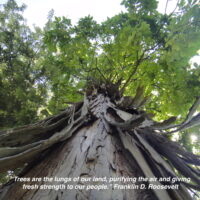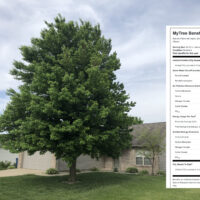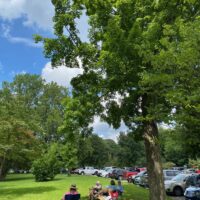 Purdue University - Extension - Forestry and Natural Resources
Purdue University - Extension - Forestry and Natural Resources
Got Nature? Blog
Purdue Landscape Report: J. Sterling Morton had a strong enthusiasm for trees and advocated intensely for individuals and civic groups to plant them. Once he became secretary of the Nebraska Territory, he further spread his message of the value of trees and Morton first proposed a tree planting holiday to be called “Arbor Day” at a meeting of the State Board of Agriculture.
The celebration date was set for April 10, 1872. Prizes were offered to counties and individuals for the largest number of properly planted trees on that day. It was estimated that more than 1 million trees were planted in Nebraska on the first Arbor Day.
Many other states also passed legislation to observe Arbor Day each year. By 1920, more than 45 states and territories were celebrating Arbor Day. The tree planting tradition became prominent in schools across the nation in 1882, with students were learning about the importance of trees as well as receiving a tree to plant in their own yard. They continue to do so today in many states.
Currently, Arbor Day is celebrated in all 50 states. The most common date for the state observance is the last Friday in April — National Arbor Day — but a number of state Arbor Days are at other times to coincide with the best tree planting weather, from January and February in the south to May in the far north.
Find out when people in your state gather together to plant and celebrate trees.
So, just why do we celebrate trees? They are essential to our health and quality of life. Trees provide many benefits, called ecosystem services, that impact nearly every aspect of our daily life. Trees improve air and water quality, reduce heating and cooling costs, improve health outcomes, increase business, and so much more. Simply stated, we need trees.
How do we determine the value of those benefits trees provide where we live? Research and technology have made it much easier to quantify those ecosystem services. The value of your tree and the ecosystem services it provides can be found by visiting this web page. It’s fun and easy to find out just what your tree contributes to the urban forest.
Join us in paying tribute to our trees which make up our urban forests by selecting and planting a tree where you live or taking part in a community tree planting. Learn how to choose and plant a tree properly to help improve the longevity and hopefully it will be providing those benefits in the future for your grandchildren and beyond. Trees can be a living legacy to great environmental stewardship. Plant trees not just for the future, but with a future. Some additional resources are available below:
For the best advice on tree planting and care, seek out a tree care professional with the experience and expertise to care for your trees. Search for a tree care provider in your area. Also, consider hiring an ISA Certified Arborist which can be found here.
Resources
Tree Appraisal and the Value of Trees, The Education Store, Purdue Extension resource center
Resources and Assistance Available for Planting Hardwood Seedlings, The Education Store
Tree Support Systems, The Education Store
Tree Planting Part 1: Choosing A Tree, Video, Purdue Extension YouTube channel
Tree Planting Part 2: Planting Your Tree, Purdue Extension Video
Planting Problems: Trees Planted Too Deep, Video, Purdue Extension – Forestry and Natural Resources
Tree Selection for Landscape, Purdue Extension – FNR Video
Tree Installation for the Landscape, Purdue Extension – FNR Video
Tree Pruning for the Landscape, Purdue Extension – FNR Video
Lindsey Purcell, Urban Forestry Specialist
Purdue University, Department of Forestry and Natural Resources

Recent Posts
- Report Spotted Lanternfly – Purdue Landscape Report
Posted: April 10, 2024 in Alert, Forestry, Invasive Insects, Plants, Wildlife, Woodlands - Declining Pines of the White Variety – Purdue Landscape Report
Posted: in Alert, Disease, Forestry, Plants, Wildlife, Woodlands - Are you seeing nests of our state endangered swan? – Wild Bulletin
Posted: April 9, 2024 in Alert, Forestry, How To, Wildlife - Cicadas in Spring! – Purdue Landscape Report
Posted: in Forestry, Plants, Safety, Wildlife - New Deer Impact Toolbox
Posted: April 7, 2024 in Forestry, Land Use, Plants, Publication, Safety, Wildlife, Woodlands - 2024-25 Fishing Guide now available – Wild Bulletin
Posted: April 4, 2024 in Alert, Aquaculture/Fish, Aquatic/Aquaculture Resources, How To, Ponds, Wildlife - Help Research Chronic Wasting Disease – Wild Bulletin
Posted: April 3, 2024 in Disease, Forestry, How To, Safety, Wildlife, Woodlands - Indiana Reptiles and Amphibians – IFWOA Webinar
Posted: April 1, 2024 in Forestry, How To, Webinar, Wildlife, Woodlands - Birding through the Seasons – IFWOA Webinar
Posted: in Forestry, How To, Webinar, Wildlife, Woodlands - Look Out for Invasive Carp in Your Bait Bucket – Wild Bulletin
Posted: March 31, 2024 in Alert, Aquaculture/Fish, Aquatic/Aquaculture Resources, Invasive Animal Species, Wildlife
Archives
Categories
- Alert
- Aquaculture/Fish
- Aquatic/Aquaculture Resources
- Ask the Expert
- Christmas Trees
- Community Development
- Disease
- Drought
- Forestry
- Forests and Street Trees
- Gardening
- Got Nature for Kids
- Great Lakes
- How To
- Invasive Animal Species
- Invasive Insects
- Invasive Plant Species
- Land Use
- Natural Resource Planning
- Nature of Teaching
- Plants
- Podcasts
- Ponds
- Publication
- Safety
- Timber Marketing
- Uncategorized
- Urban Forestry
- Webinar
- Wildlife
- Wood Products/Manufacturing
- Woodland Management Moment
- Woodlands



